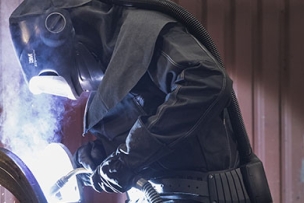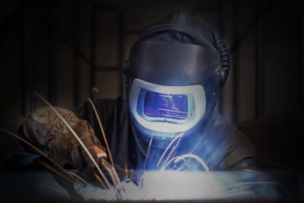Products that work as hard as you do. From the most basic to the most specialized needs, 3M offers the health and safety protection you and your workers need most, so everyone can perform at their best. We strive to deliver comfortable, well-designed personal protective equipment (PPE) that offers your workers the most effective protection available.
Paper, lumber, mills, building businesses and houses. Wood is used in all types of industries and forming wood products creates sawdust. But what is wood?
Wood is actually a porous and fibrous structural tissue found in the stems and roots of trees and other woody plants. It is an organic material, a natural composite of cellulose fibers that are strong in tension and embedded in a matrix of lignin that resists compression. Cutting and finishing wood can produce significant amounts of dust. Some of the professions where there is an increased risk of wood dust exposure include logging, sawmills, furniture and cabinet making, carpentry, wooden boat building, and construction. But did you realize wood dust may be hazardous to your health?
What are Wood Dust Health Hazards and Exposure Limits?
Breathing wood dust particles may cause allergic respiratory symptoms, mucosal and non-allergic respiratory symptoms, and other potentially serious health problems.[i] The extent of these hazards and the associated wood types have not been clearly established. Wood dust is associated with adverse health effects including irritation of the eyes, nose and throat, which can result in coughing and wheezing, dermatitis, and short- and long-term respiratory system effects, which may include decreased lung capacity, occupational asthma, and allergic reactions (e.g. hypersensitivity pneumonitis).[ii]
Health issues can arise not just from wood dust but by the natural chemicals in different types of wood as well as bacteria, molds or fungi that are found in or on wood.[iii] These wood dust and other particulates may be associated with adverse health effects, including, but not limited to, headaches, loss of weight, breathlessness, giddiness, cramps, and other more potentially serious health issues.[iv]
Possible Wood Dust Hierarchy of Control Options
Here are some engineering controls that should be considered and implemented, if possible:
- Substitute with another type of wood with no or fewer known health effects.
- Reduce dust generation. For example, minimize cuts by reviewing/changing wood design.
- Use abrasives with through holes that minimize dust production.
- Use an appropriately designed ventilation system, including local ventilation exhaust with high-efficiency particulate (HEPA) filters.
- Use on-tool ventilation extraction systems.
- Maintain the sharpness and life of your abrasives and tools.
Additionally, those who produce wood dust on a worksite should also consider available administrative controls, such as the following:
- Practice good housekeeping such as vacuuming.
- Do not blow settled dust.
- Bag and seal dust waste to prevent dust from re-entering the air.
- Use wet clean-up methods (e.g., wipe surfaces with a wet rag or mop).
- Practice good personal hygiene (e.g., wash or shower to remove dust from skin).
- Clean clothes by washing or using a vacuum when washing facilities are not available.
- Develop and implement safety manuals, and guidelines, that outline processes and procedures to help identify hazards and steps that can be taken to mitigate risks associated with these hazards.
These procedures set out the standards employees must adhere to in order to help manage the hazards that have been identified on the particular jobsite in accordance with the Hazard Communication Standard set out by U.S. OSHA.[v] Employers and their safety managers must provide appropriate education and training to employees, including the hazards of wood dust exposure, safe work procedures, and standards of practice (SOPs)/job/task work procedures. Employers and safety managers must also consider the importance of other control measures, including how to use appropriate personal protective equipment (PPE), including respiratory protection, when necessary.
Respiratory Protection Considerations
There are many different types of respirators that can help reduce worker exposures. As part of selecting appropriate respiratory protection, employers should conduct an exposure assessment to identify the relevant hazards and exposures. This is a key element of their respiratory protection program.
There are different filtering facepiece respirators (FFR), reusable respirators (RR) and powered air purifying respirators (PAPR) that offer various particulate filtration attributes as well as a wide variety of features and benefits. There are many respiratory protection options available for your unique situation including valved and unvalved filtering facepiece respirators, elastomeric respirators, and PAPRs for those wearers who want to maintain facial hair. You should seek out a reputable manufacturer and work with respiratory protection specialists who can help you determine what may best fit your woodworking application or job.
Cutting, processing and finishing wood can produce significant amounts of dust that may result in a number of health-related issues depending on the nature, level and duration of exposure. There are a wide variety of control measures that can be put in place to help reduce elevated dust levels from choosing tools that can help reduce dust creation to cleaning procedures as well as wearing appropriate respiratory protection equipment. For questions about implementing these measures and selecting respiratory protection for your worksite, please do not hesitate to reach out to 3M for assistance today.
Previously Featured on 3M's Resources page.
Resources:
[i] https://www.osha.gov/wood-dust
[ii] https://www.cdc.gov/niosh/docs/wooddust/pdfs/exposures-references.pdf
[iii] https://www.ccohs.ca/oshanswers/chemicals/wood_dust.html
[iv] https://www.ccohs.ca/oshanswers/chemicals/wood_dust.html
[v] https://www.osha.gov/hazcom








Talk to Us!
Leave a reply
Your email address will not be published. Required fields are marked *